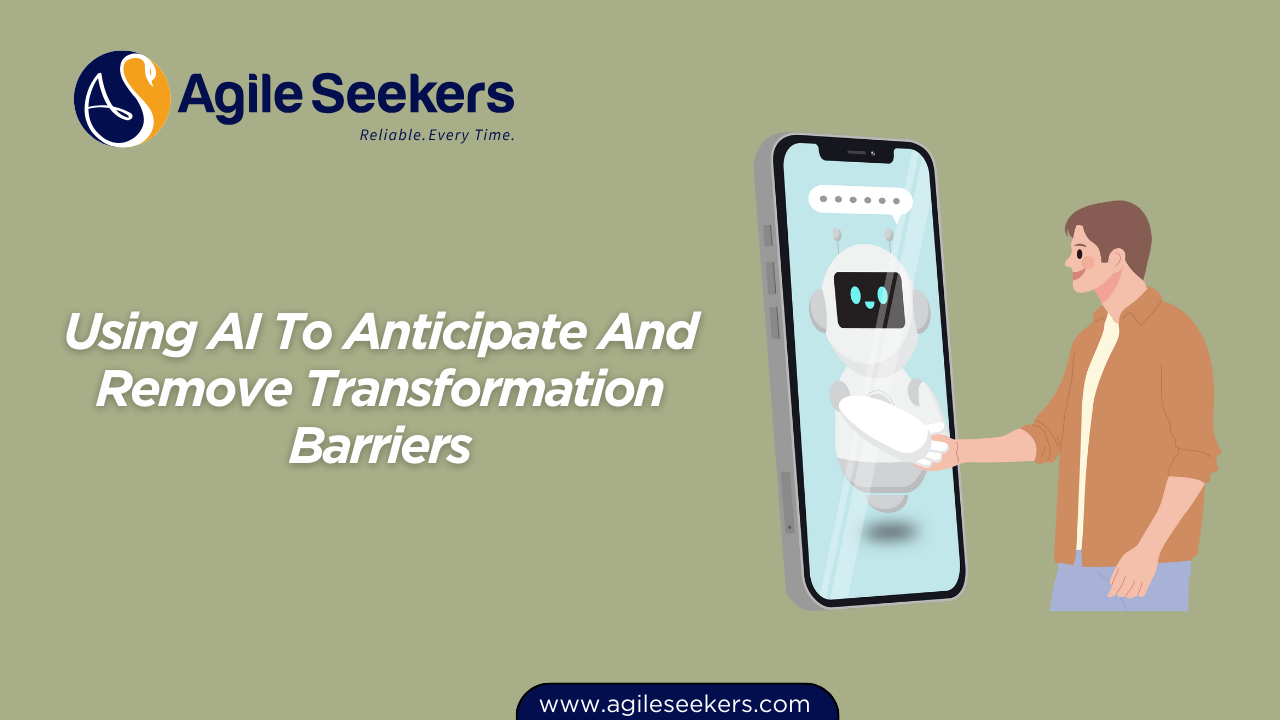Using AI To Anticipate And Remove Transformation Barriers

Organizational transformations often stall not because of lack of intent but because of hidden barriers—resistance to change, misaligned priorities, or inefficient processes. What leaders and teams need is not just hindsight but foresight.
That’s where Artificial Intelligence steps in. AI can help organizations identify risks earlier, predict potential blockers, and even recommend solutions before those barriers take shape.
Let’s break down how AI can become a proactive partner in driving transformation success.
Why Transformation Barriers Persist
Every transformation effort—Agile adoption, digital transformation, or restructuring—faces hurdles. Common ones include:
-
Cultural resistance: Teams hold on to old ways of working.
-
Lack of visibility: Leaders don’t see bottlenecks until it’s too late.
-
Misaligned incentives: Teams optimize for local goals rather than shared outcomes.
-
Data overload: Decisions take longer because insights get lost in noise.
Traditionally, leaders rely on retrospective reports, surveys, or workshops to spot these issues. The drawback? By the time a barrier is visible, it’s already causing damage.
How AI Anticipates Barriers Before They Surface
AI flips this reactive approach by using data-driven prediction. Here’s how:
-
Behavior Pattern Recognition
AI-powered tools analyze communication, task completion, and collaboration patterns to spot early warning signals. For example, if a project team shows declining engagement in sprint reviews, the AI system can flag potential disengagement before it spreads. -
Sentiment and Feedback Analysis
By scanning feedback from retrospectives, chat tools, or employee surveys, AI can detect negative trends in team morale. Instead of waiting for complaints to pile up, leaders get an early signal to intervene. -
Predictive Flow Metrics
AI models forecast throughput, cycle times, and backlog health. This allows transformation leaders to see which dependencies may create bottlenecks in the next quarter rather than discovering them mid-release. -
Risk Simulation
Some advanced AI systems run “what-if” scenarios. For instance, they can model how delaying one feature impacts downstream initiatives, helping leaders prioritize with foresight.
Removing Barriers with AI-Driven Interventions
Once barriers are identified, AI helps in eliminating them with targeted actions:
-
Optimized Resource Allocation: AI highlights overloaded teams and suggests redistributing capacity to balance delivery.
-
Alignment Recommendations: By comparing portfolio objectives with actual work items, AI pinpoints misaligned efforts.
-
Coaching Insights: AI dashboards provide Scrum Masters and Agile Coaches with patterns about recurring impediments, enabling them to coach more effectively.
-
Automated Nudges: Intelligent assistants can remind teams about dependencies, upcoming deadlines, or unaddressed risks, keeping transformation on track.
For professionals aiming to harness these capabilities, structured learning is crucial. Programs like the AI for Agile Leaders & Change Agents Certification provide the skills to lead change initiatives with AI-enhanced strategies.
Role of AI Across Transformation Leaders
AI doesn’t just serve executives—it provides tailored benefits to each role in a transformation journey.
For Project Managers
Project Managers often face complexity from cross-team dependencies. AI can map these dependencies in real-time and warn about potential delays before they cascade. Enrolling in AI for Project Managers Certification Training helps professionals learn how to use these AI tools to de-risk delivery.
For Product Owners
Product Owners must balance customer value with delivery constraints. AI helps by forecasting customer demand, prioritizing features based on data, and identifying which backlog items may carry hidden risks. The AI for Product Owners Certification Training equips POs with these predictive and analytical skills.
For Scrum Masters
Scrum Masters often struggle with invisible team-level barriers like low collaboration or hidden conflicts. AI-driven sentiment analysis and flow metrics shine a light on these issues early. Learning through the AI for Scrum Masters Training ensures Scrum Masters can anticipate and resolve impediments faster.
Case Examples of AI Removing Transformation Barriers
-
Predicting Drop in Engagement: One organization used AI-driven analytics on meeting participation data. The system highlighted a decline in engagement among two squads. Early coaching intervention reversed disengagement, saving the transformation momentum.
-
Uncovering Misalignment: A global enterprise leveraged AI to map work items against portfolio OKRs. The analysis revealed 30% of work had no alignment to strategic goals. Adjustments ensured resources were directed toward initiatives that mattered.
-
Reducing Delivery Risks: An agile release train integrated AI-driven risk simulation. The model showed that delaying one feature by three sprints would delay four dependent initiatives. Armed with this insight, leaders reprioritized features and avoided cascading delays.
For a deeper dive into how AI enhances transformation outcomes, McKinsey has highlighted how AI accelerates digital transformations by reducing uncertainty and improving decision-making (source).
Practical Steps to Get Started
-
Identify Data Sources: Transformation leaders should integrate data from task boards, HR systems, and collaboration tools.
-
Start Small with Predictive Dashboards: Begin with AI dashboards that highlight engagement and flow metrics.
-
Invest in Role-Specific Training: Leaders, Project Managers, Product Owners, and Scrum Masters should upskill with AI-driven certifications.
-
Create a Feedback Loop: Use AI insights not as static reports but as prompts for continuous improvement conversations.
Final Thoughts
Transformation barriers aren’t going away. But with AI, leaders no longer need to wait until those barriers derail progress. By predicting, identifying, and addressing challenges before they materialize, organizations can sustain momentum and achieve business agility faster.
The message is clear: if you want transformation success, pair human leadership with AI foresight.
Also read - How AI Strengthens Alignment From Vision To Execution
Also see - The Future Of Portfolio Planning With AI Enabled Insights




















